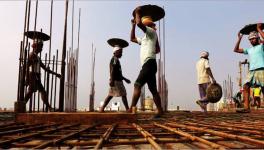Inflation Hits Small, Medium Eateries of Maharashtra
April 2 was another typical day for 64-year-old Jagdish Mali. After brewing tea on the gas stove around 5 am, he was waiting for his regular customers, the nightshift workers of the Maharashtra Industrial Development Corporation, Dombivli.
After a few minutes, Mali was shell-shocked when he was informed that the price of a commercial LPG cylinder had been hiked by Rs 250. “How will I sustain with no increase in the number of customers and the frequent hike in gas price? I sell a cup of tea for Rs 12 but most of my customers ask for half a cup. At least, people like me should be excluded from gas price hikes,” Mali, who purchases a cylinder for Rs 2,200, tells Newsclick.
Mali is one of the countless numbers of small and medium eatery owners of Maharashtra who have been severely impacted by the increasing inflation.
Alhad Joshi, the owner of Thane’s famous tiffin centre A1 Kitchen, plans to reduce the size of his thali. The eatery, which prepares 350 tiffin boxes daily, has a steady stream of 200-250 customers from the lower-middle class—autorickshaw drivers, marketing agents and small garage owners—during lunch hours. The Rs 40 thali contains four chapatis, rice, two vegetables, dal, one curry, a poppadom, pickle and curd.
“I can’t afford to serve two vegetables, curry and curd. Soon, we will serve curd only on demand. We have no choice but to reduce the number of items,” says Joshi. “The increase in the prices of gas cylinders and vegetables has left us with no other option. My customers cannot afford to pay more for a thali.”
Shakuntala Vanjari (48), who sells breakfast outside the Tata Memorial Hospital, Parel, at affordable rates, is in a financial predicament. She cooks poha, upma, dosa and idli at her chawl and sells them for Rs 20-Rs 25 per plate.
“I have decided to increase the price of each item by, at least, Rs 5-Rs 10. I fear losing customers, who are mostly poor and can’t spend much. But I have no other option,” says Vanjari. “Even lemons are costlier. Now, I have to shell out Rs 20 for four lemons as against Rs 10 earlier. Same with coriander leaves. There is no place for the poor in this country,” a sad Vanjari tells Newsclick.
Due to the increasing prices of essential items, more poor residents are flocking to the Maha Vikas Aghadi’s Shiv Bhojan scheme, which provides two chapatis, one vegetable, rice, dal and pickle for only Rs 10. There are more than 10,000 Shiv Bhojan stalls across the state.
As per the state food and civil supply department, the actual cost of one subsidised thali is Rs 29.5. One stall sells a maximum of 300 meals per day. “When the pandemic was raging, we sold 220-250 plates per day. But the sale has increased in the last one month with the number crossing 300 plates per day,” says Ekvira Samajik Mandal’s Ashok Kamete, who runs a Shiv Bhojan stall at Santacruz Electronics Export Processing Zone, Andheri.
Experts believe that the increasing prices of essential items and unaffordability of proper diet could result in a huge hunger crisis and malnutrition among the poor. Famous dietician Shilpa Joshi tells Newsclick that malnutrition could increase. “Due to inflation, owners of eateries start reducing the number of food items and people also consume less. This affects the supply of essential nutrients to the body. Many financially weak families are in facing trouble now—women and children are especially affected.
Get the latest reports & analysis with people's perspective on Protests, movements & deep analytical videos, discussions of the current affairs in your Telegram app. Subscribe to NewsClick's Telegram channel & get Real-Time updates on stories, as they get published on our website.
























